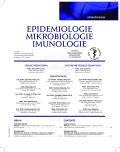Stenotrophomonas maltophilia as the cause of ventilator-associated pneumonia in a female patient with toxic epidermal necrolysis and Clostridium colitis: time for off-label tigecycline?
Authors:
B. Lipový 1,2; H. Řihová 1; M. Hanslianová 3; I. Suchánek 1; P. Brychta 1,2
Authors‘ workplace:
Klinika popálenin a rekonstrukční chirurgie FN Brno
1; Lékařská fakulta Masarykovy univerzity Brno
2; Oddělení klinické mikrobiologie, FN Brno
3
Published in:
Epidemiol. Mikrobiol. Imunol. 65, 2016, č. 3, s. 177-181
Category:
Original Papers
Overview
Toxic epidermal necrolysis (TEN) is an autoimmune disease which is usually caused by a reaction to drugs. It affects mainly the skin and mucous membranes. It is a rare condition with a high mortality rate. Fatal outcomes in patients with TEN are mostly due to infectious complications. As antimicrobial drugs may induce this syndrome, the management of this condition is very complicated. Tigecycline is still a relatively new antibiotic approved in Europe for use in complicated intra-abdominal infections and complicated skin and soft tissue infections. Among major advantages of tigecycline in patients with TEN are its good penetrability into tissues, wide spectrum of activity that makes it suitable for use as monotherapy, and last but not least, in comparison with other antimicrobials, a very low potential for exacerbation of the severity of the underlying disease by further stimulation of the immune system. A case report is presented of a successful management of an 81-year-old woman with TEN and multiple infectious complications in different anatomic locations, the most serious of which was ventilator-associated pneumonia caused by Stenotrophomonas maltophilia. Her general condition was further aggravated by Clostridium colitis. Tigecycline was used as the therapeutic option for ventilator-associated pneumonia, although prescribed off-label.
Key words:
toxic epidermal necrolysis – tigecycline – off-label indications – Clostridium colitis
Sources
1. Harr T., French LE. Toxic epidermal necrolysis and Steven-Johnson syndrome. Orphanet J Rare Dis 2010;5: 39–50.
2. de Prost N, Ingen-Housz-Oro S, Duong T et al. Bacteremia in Stevens-Johnson syndrome and toxic epidermal necrolysis: epidemiology, risk factors, and predictive value of skin cultures. Medicine (Baltimore). 2010;89(1):28–36.
3. Bastuji-Garin S, Fouchard N, Bertocchi M, et al. SCORTEN: a severity-of-illness score for toxic epidermal necrolysis. J Invest Dermatol. 2000;115(2):149–153.
4. Craven DE, Hjalmarson KI. Ventilator-associated tracheobronchitis and pneumonia: thinking outside the box. Clin Infect Dis. 2010;51(Suppl 1):S59–66.
5. Vélez L, Correa LT, Maya MA, et al. Diagnostic accuracy of bronchoalveolar lavage samples in immunosuppressed patients with suspected pneumonia: analysis of a protocol. Respir Med. 2007;101(10):2160–2167.
6. Betts JW, Phee LM, Woodford N, Wareham DW. Activity of colistin in combination with tigecycline or rifampicin against multidrug-resistant Stenotrophomonas maltophilia. Eur J Clin Microbiol Infect Dis. 2014;33(9):1565–1572.
7. Tekçe YT, Erbay A, Cabadak H, Sen S. Tigecycline as a therapeutic option in Stenotrophomonas maltophilia infections. J Chemother. 2012;24(3):150–154.
8. Fomin P, Beuran M, Gradauskas A, et al. Tigecycline is efficacious in the treatment of complicated intra-abdominal infections. Int J Surg. 2005;3(1):35–47.
9. Breedt J, Teras J, Gardovskis J, et al. Safety and efficacy of tigecycline in treatment of skin and skin structure infections: results of a double-blind phase 3 comparison study with vancomycin-aztreonam. Antimicrob Agents Chemother. 2005;49(11):4658–4666.
10. Dartois N, Cooper CA, Castaing N, et al. Tigecycline versus levofloxacin in hospitalized patients with community-acquired pneumonia: an analysis of risk factors. Open Respir Med J. 2013;7:13–20.
11. Conde-Estévez D, Grau S, Horcajada JP et al. Off-label prescription of tigecycline: clinical and microbiological characteristics and outcomes. Int J Antimicrob Agents. 2010;36(5):471–472.
12. Curcio D, Vargas SW, Ugarte Ubiergo S, et al. Tigecycline treatment of critically ill patients: the LatinUser experience. Curr Clin Pharmacol. 2011;6(1):18–25.
13. Mouloudi E, Massa E, Piperidou M, et al. Tigecycline for treatment of carbapenem-resistant Klebsiella pneumoniae infections after liver transplantation in the intensive care unit: a 3-year study.Transplant Proc. 2014;46(9):3219–3221.
14. Guner R, Hasanoglu I, Keske S, et al. Outcomes in patients infected with carbapenem-resistant Acinetobacter baumannii and treated with tigecycline alone or in combination therapy. Infection. 2011;39(6):515–518.
15. Theriot CM, Schumacher CA, Bassis CM, et al. Effects of tigecycline and vancomycin administration on established Clostridium difficile infection. Antimicrob Agents Chemother. 2015;59(3):1596–1604.
16. Britt NS, Steed ME, Potter EM, et al. Tigecycline for the Treatment of Severe and Severe Complicated Clostridium difficile Infection. Infect Dis Ther. 2014;3(2): 321–331.
17. Aldape MJ, Heeney DD, Bryant AE, et al. Tigecycline suppresses toxin A and B production and sporulation in Clostridium difficile. J Antimicrob Chemother. 2015;70(1):153–159.
18. Mockenhaupt M, Viboud C, Dunant A, et al. Stevens-Johnson syndrome and toxic epidermal necrolysis: assessment of medication risks with emphasis on recently marketed drugs. The EuroSCAR-study. J Invest Dermatol. 2008;128(1):35–44.
Labels
Hygiene and epidemiology Medical virology Clinical microbiologyArticle was published in
Epidemiology, Microbiology, Immunology

2016 Issue 3
Most read in this issue
- Stenotrophomonas maltophilia as the cause of ventilator-associated pneumonia in a female patient with toxic epidermal necrolysis and Clostridium colitis: time for off-label tigecycline?
- Avidity of selected autoantibodies – usefulness of their determination for clinical purposes
-
The occurrence of Ixodes ricinus ticks and important tick-borne pathogens in areas with high tick-borne encephalitis prevalence in different altitudinal levels of the Czech Republic
Part II. Ixodes ricinus ticks and genospecies of Borrelia burgdorferi sensu lato complex - HIV/AIDS epidemics in sub-Saharan regions in the 2010s: Regional analysis of UNAIDS data
